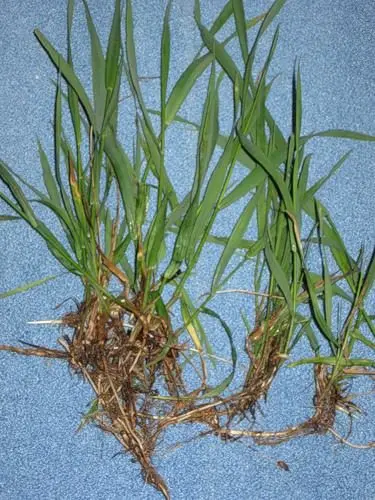Contents
Useful properties and recipes for the use of wheatgrass
Botanical characteristics of wheatgrass

Creeping wheatgrass is a perennial plant belonging to the bluegrass family. The long rhizomes of the plant are in the soil in a horizontal position. Branching roots on their tops begin to bend and end up on the surface of the soil, thereby a new individual of wheatgrass appears. On the erect stems of the plant are leaves that have a flat linear plate, which has a rough surface on top. Inconspicuous wheatgrass flowers are collected in inflorescences-spikelets of several pieces. Each flower consists of a perianth, stamens and pistil. The fruit of the plant is a grain, which contains one seed.
The plant blooms in late spring – early summer. Fruit ripening begins in July and lasts until the beginning of autumn. Wheatgrass is found throughout Russia in gardens, parks, wastelands, meadows and forest edges. Wheatgrass often grows under fences in settlements.
Reproduction of wheatgrass
Wheatgrass propagates vegetatively and by seeds. The vegetative method involves the use of plant rhizomes, which are planted in the soil and monitor their development and growth. In order for regeneration to occur, just a particle of the rhizome with a kidney is enough. Most often, wheatgrass is propagated in this way.
Wheatgrass is a cross-pollinated plant, so new individuals become stronger and more resistant to poor conditions. If the conditions for the development of the plant are unfavorable, then the caryopsis will be at the dormant stage, in which the viability of the plant will remain for a couple of years. Seeds grow best and fastest in fertile soil, which includes nitrogen.
Useful properties of wheatgrass
Wheatgrass contains fatty oils, fructose, aveline, malic acid, mucus, levulose and vitamins. The herb of this plant contains ascorbic acid and carotene. Due to this content of nutrients, wheatgrass has many medicinal properties. Wheatgrass has a diuretic and analgesic effect, which is why it is used for dropsy, nephritis, cystitis and urolithiasis. An infusion from the rhizomes of the plant helps to reduce pain in rheumatism, arthritis, gout and gallstone disease.
Wheatgrass has an anti-inflammatory and expectorant effect, which is used for coughs, pulmonary tuberculosis, gastritis, profuse sputum, bronchitis and liver diseases. Wheat grass normalizes bowel function, and it is also an excellent remedy for constipation.
The use of wheatgrass creeping

Traditional medicine often uses wheatgrass as a diaphoretic in the treatment of colds and fevers. Wheatgrass increases appetite, restores the body’s strength and normalizes sleep – all this plant owes its content of sugars and vitamins. Wheatgrass is used for vision problems, hypertension, diabetes and malignant tumors.
Wheatgrass has an antihelminthic effect, which is used in the presence of worms in pets. This plant is an ingredient in the preparation of pills. Wheatgrass baths are used for skin diseases, rickets, diathesis and hemorrhoids. Wheatgrass is part of various fees that are used for cirrhosis of the liver, cystitis and other diseases.
Diuretic decoction of wheatgrass. Take 10 grams of wheatgrass rhizomes and pour 100 ml of boiling water, put on fire for 15 minutes and strain. Take the prepared decoction 3 tablespoons three times a day before meals.
Infusion of couch grass for rheumatism. We take 4 teaspoons of the rhizomes of the plant and pour 1 cup of boiling water. We leave for 12 hours to infuse, filter. The rhizomes that remain from this infusion will be used to prepare another infusion. We take these rhizomes and pour a glass of boiling water, wrap and leave for 1 hour. Next, mix both infusions and take 70 ml 3-4 times a day. The same medicine can be treated for gout and aching joints.
Wheatgrass baths for skin diseases. Take 100 grams of wheatgrass rhizomes and mix them with 100 grams of burdock. We put everything in an enameled bucket and pour half of the bucket with boiling water. Put on fire, bring to a boil and leave for 10 minutes. Pour the broth into the bath and stay in the bath for no more than half an hour.
A decoction of wheatgrass for tuberculosis. To prepare it, you need to take 2 tablespoons of dry wheatgrass roots and pour them with a glass of milk. We put the composition on fire for 5 minutes, filter and take this medicine in one go. The decoction should be taken 3 times a day.
Contraindications to the use of wheatgrass
There are currently no contraindications to the use of medicines from couch grass.









